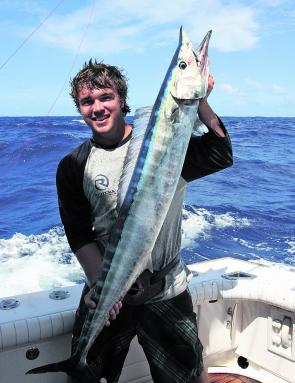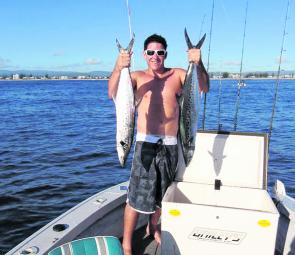March is always a great month to attach ourselves to a wide range of species in our area. This will be a bit of a transition month where our warm water pelagic are still around in healthy numbers but a range of tasty reefies will start to present themselves as our coastal currents slow.
Our light tackle marlin season so far has been pretty good but has been a bit quiet in the last month. Despite this I’m still confident that our usual run of medium class fish (50-150 kg) will still show up in march. You will most likely encounter these on the 36 fathom line, spot X and Deep Trag. Keep your eyes peeled for any bait schools that may be getting rounded up by predators. Also if you spot any pods of dolphins, this may mean bait isn’t too far away. Once bait has been located use a bait jig with about a size 4 hook and heavy sinker to drop into the bait school. You’ll find most times it won’t take long for a string of prime live baits such as slimey’s, yakkas or small bonito will be hauled aboard. My live bait rigs consist of an 8ft trace of about 150lb with a 9/0 eagle claw circle hook and try using a range of sinker sizes for best results.
Blue marlin have been showing up from time to time so far this year and i think the will only get better as we get a bit later in the season. The fish have been averaging around 150kg but there has been quite a few larger fish in the mix. 50lb tackle is absolute minimum when chasing blues and most of the big boats around are mainly using 130lb tackle these days. You will catch these fish anywhere outside the 100 meter line and as usual keep an eye out for flying fish, tuna schools and birds, these indications will show you where the fish are. Try trolling lures ranging from 9 to 17 inches I usually troll a spread of lures with various sizes and colours, different lures work on different days.
Mackerel will still be lurking about this month and by trolling hard bodied lures is an easy and effective way to catch some quality fish. Like any lure trolling use a variety of lures, colours sizes and depths for best success. My all time favourite lures are Lively Lure Blue Pilly deeps and Pilly Jnr in both purple and blue slimey colours. These lures are made locally and built super tough! I also mix it up with Halco Laser Pros and Rapala X-Raps. It’s also worth trolling a small bullet head out there, I’ve often caught some really big Spanish on little bullet head lures so they are a very handy lure to have. When trolling hard bodies I use a single strand wire trace of around 80lb. Single strand is thinner than any other trace and you will find that your lure will swim faster and deeper than it would when using other leader materials.
If you’re around the nine mile this month you’ll find there will be most likely schools of small tuna chopping the surface and eating your trolled and spun lures. By using a twin 9/0 hook rig on 100lb wire you can troll these jelly bean size tuna around and catch some monster Wahoo and mackerel. Hook your front hook through the tuna’s top jaw and the back one down near the tail and troll them as slow as possible. A bait like that usually won’t be out there long before something finds it.
March is always a good time to start chasing a few nice snapper around our close reefs. Anywhere around the 18s or 24s with a nice bit of reef will be a good place to come across a few good reds. By slowly drifting down pillies or strip baits on as lighter sinker as possible is the best way to approach a snapper reef. I use a 3 gang of 5/0 hooks, I like to use ganged hooks in case of a stray mackerel or if there’s a few tailor about, there’s less chance of being bitten off. I like to also use monofilament line instead of braid when snapper fishing purely because I find that less hooks are pulled during the fight.
That first push of clean water around the Southport seaway will bring with it big schools of white pilchards. This is a gold mine for the ravenous tailor. There’s plenty to be had this time of year and any small size metal lure will not usually be passed up. Just keep an eye out for any birds working and the tailor schools won’t be far behind. If you have an electric motor it is a big help, because you can silently follow the tailor schools resulting in bigger numbers of fish caught, but if you don’t have the luxury of an electric, turn off your motor just up wind or up tide of the school and let the elements work to your advantage.
There will still be a few jacks destroying gear this month and by timing the last part of the run out tide and locating yourself near a good bit of structure you will be in with a shot. Two of my more reliable spots are the council chambers in the Nerang River and the Chinderah rock wall in the tweed. Both of these spots provide the facilities for a good long troll run or can be worked thoroughly with cast lures. I like a deep diving yet buoyant lure such as a lively lure mad mullet to cast around spots like this. So that if you feel your lure swim into a snag, simply by pausing the lure it will float back off of the rock, log, shopping trolley or whatever piece of structure may present itself in these areas.
There should still be a few whiting up the Nerang river around the council chambers and buds beach. I use either blood worms or small black soldier crabs for bait. Stealth is often the key to success with any fishing and big whiting are no exception. I try and use long light fluoro carbon leaders of around 8lb and as long as you can cast comfortably. The rig i find best is a running ball sinker, up to around a 5 ball depending on the tide flow, down to a swivel and then your fluoro leader down to a long shanked no.6 hook.
You will find the Hinze Dam will be looking a lot different than what you may be used to after all of the flooding we have had in the gold coast area earlier in the year. And you may find yourself re-learning the prime fishing areas. You will get most number at this time of year off the points and you will start seeing numbers holding up in the deeper sections of the dam. I find at this time of year slowly rolling plastics like Ecogear Grass Minnows or vx50 blades along the bottom or hopping masks down deep being far more productive. But spot selection can be crucial for these at times fickle fish. Deep points or bends in the main part of the dam are good places to start but sounding around the old river bed searching for schools of fish can be a good way of locating a good haul of usually better quality bass.
Reads: 1639
Wahoo are about in numbers amongst the hoards of mackerel. Better fish will be available in March.

They’re not all Spaniards with some really nice spotties on the close reefs mixing it up with the Spaniards.




